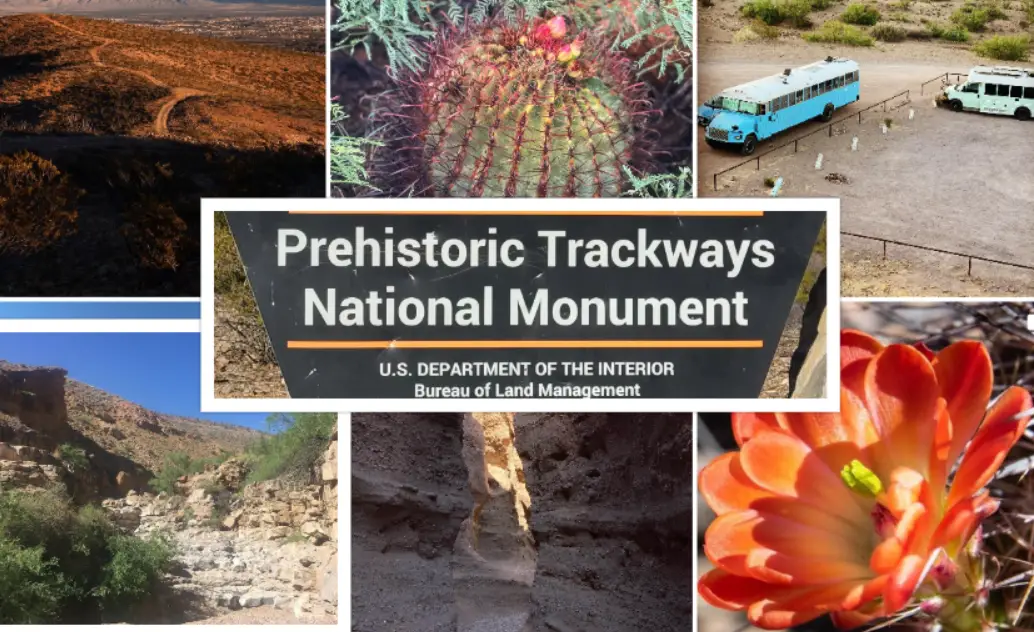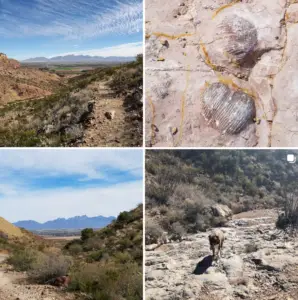Prehistoric Trackways National Monument : Interesting Facts, History & Travel Guide

- By
- Aparna Patel
- |
- 13 Apr, 2023
- |

Prehistoric Trackways National Monument, located in southern New Mexico, is a unique and fascinating destination that offers visitors a glimpse into the distant past. The monument is home to some of the most extensive and well-preserved fossilized trackways in the world, dating back over 280 million years.
These trackways offer insights into the lives and behaviors of prehistoric animals, including ancient reptiles, amphibians, and insects. In this guide, we’ll delve into the rich history and significance of Prehistoric Trackways, as well as provide practical travel information for visitors who want to explore this unique destination.
From guided tours to hiking trails, we’ll cover all the best ways to experience the natural beauty and scientific significance of Prehistoric Trackways National Monument. Whether you’re a paleontology enthusiast, a nature lover, or simply looking for a one-of-a-kind travel experience, Prehistoric Trackways National Monument is definitely worth a visit.
Table of Contents
Interesting facts about Prehistoric Trackways National Monument
- Prehistoric Trackways National Monument is located in southern New Mexico and covers more than 5,200 acres of land.
- The monument is home to some of the world’s most significant and scientifically valuable fossil footprints, including those of reptiles, amphibians, and insects.
- The trackways found in the monument are believed to be between 280 and 290 million years old, making them some of the oldest known vertebrate tracks in the world.
- The footprints found in Prehistoric Trackways National Monument are so well-preserved that they show intricate details such as skin impressions, claw marks, and tail drag marks.
- The site was first discovered in 1987 by Jerry MacDonald, a local landowner, and amateur paleontologist.
- The monument also contains evidence of ancient plants, including an extensive petrified forest that is estimated to be around 280 million years old.
- The area around Prehistoric Trackways National Monument was once part of an ancient tropical swamp, which explains the abundance of fossilized plant and animal remains.
- The monument was officially designated by President Barack Obama in 2014, making it one of the newest national monuments in the United States.
- The monument is a popular destination for scientists, paleontologists, and educators, who come to study and learn about the area’s prehistoric past.
- Visitors to Prehistoric Trackways National Monument can explore the site on their own or take a guided tour with a park ranger. The monument also features several hiking trails, picnic areas, and other recreational opportunities.
Read More:
- Pompeys Pillar National Monument : Interesting Facts, History & Travel Guide
- Pipe Spring National Monument : Interesting Facts, History & Travel Guide
- Petroglyph National Monument : Interesting Facts, History & Travel Guide
- Organ Pipe Cactus National Monument : Interesting Facts, History & Travel Guide
Information & History of Prehistoric Trackways National Monument
Prehistoric Trackways National Monument is located in the Robledo Mountains, near Las Cruces, in southern New Mexico, United States. The monument covers over 5,200 acres of land, which contains some of the world’s most significant and scientifically valuable fossil footprints. The footprints in the monument are believed to be between 280 and 290 million years old, dating back to the Permian period, making them some of the oldest known vertebrate tracks in the world.
The monument’s tracks are from a wide range of species, including reptiles, amphibians, and insects. The tracks provide valuable insight into the behavior and anatomy of these prehistoric animals. In addition to the tracks, the monument is home to an extensive petrified forest, which is estimated to be around 280 million years old. The area was once a tropical swamp, which explains the abundance of fossilized plant and animal remains.
The area that now comprises the Prehistoric Trackways National Monument was first discovered in 1987 by Jerry MacDonald, a local landowner and amateur paleontologist. MacDonald recognized the significance of the site’s fossilized tracks and began working to protect the area from looting and development. In 2009, the site was designated a national natural landmark by the National Park Service. In 2014, President Barack Obama designated the area a national monument, making it one of the newest national monuments in the United States.
Today, Prehistoric Trackways National Monument is managed by the Bureau of Land Management (BLM) and is open to the public. Visitors can explore the site on their own or take a guided tour with a park ranger. The monument also features several hiking trails, picnic areas, and other recreational opportunities. The monument is a popular destination for scientists, paleontologists, and educators, who come to study and learn about the area’s prehistoric past.
Travel Guide for Prehistoric Trackways National Monument
- Getting There: The nearest major airport is in El Paso, Texas, which is about an hour’s drive from the monument. The monument is located just outside of Las Cruces, New Mexico, which is easily accessible by car via Interstate 25. There is no public transportation to the monument.
- Visiting Hours: The monument is open year-round, from sunrise to sunset. The Visitor Center is open daily from 8:00 am to 4:00 pm, except for major holidays.
- Entrance Fees: There are no entrance fees to visit Prehistoric Trackways National Monument.
- Things to Do: The monument features several hiking trails, including the Dripping Springs Trail, which is a 2.2-mile round trip hike that takes visitors to a waterfall and a historic ranch site. There is also the Robledo Ridge Trail, which offers stunning views of the surrounding mountains. The monument also has several picnic areas and restroom facilities.
- Guided Tours: The monument offers guided tours with park rangers on Saturdays during the fall and spring seasons. The tours last about two hours and provide visitors with an in-depth look at the site’s geology, history, and paleontology. Reservations are required for the guided tours and can be made by contacting the monument’s Visitor Center.
- What to Bring: Visitors to the monument should bring water, sunscreen, and comfortable hiking shoes. It is also recommended that visitors bring binoculars or a camera to capture the stunning views and unique features of the monument.
- Accommodations: There are several hotels and motels in Las Cruces and the surrounding area, as well as camping and RV facilities in nearby state parks.
- Safety: Visitors should be aware of the potential hazards of hiking in a desert environment, including dehydration, sunburn, and encounters with wildlife. Visitors should also stay on designated trails and not disturb the monument’s fragile ecosystem.
- Accessibility: The monument’s Visitor Center and restrooms are wheelchair accessible, but some of the hiking trails may not be suitable for visitors with mobility issues. Visitors with disabilities should contact the monument’s Visitor Center for more information on accessibility.
Prehistoric Trackways National Monument is a unique and fascinating destination for anyone interested in the prehistoric past. With its well-preserved fossilized tracks, stunning scenery, and recreational opportunities, it is a must-visit destination for anyone traveling to southern New Mexico.
More Post
- Mount St. Helens Volcanic : Interesting Facts, History & Travel Guide
- Montezuma Castle National Monument : Interesting Facts, History & Travel Guide
- Mojave Trails National Monument : Interesting Facts, History & Travel Guide
- Misty Fjords National Monument : Interesting Facts, History & Travel Guide
FAQ about Prehistoric Trackways National Monument
What are the trackways at Prehistoric Trackways National Monument?
The trackways at Prehistoric Trackways National Monument are fossilized tracks left by ancient animals, including dinosaurs and other prehistoric reptiles. These tracks were made over 280 million years ago and are some of the oldest and best-preserved trackways in the world.
Can I touch the fossils or take them home?
No, it is illegal to remove fossils from the monument or to damage them in any way. The monument is protected by law, and visitors should not touch or remove any fossils or other artifacts.
Are there guided tours available at the monument?
Yes, the monument offers guided tours with park rangers on Saturdays during the fall and spring seasons. The tours provide visitors with an in-depth look at the site’s geology, history, and paleontology.
Is there an entrance fee to visit Prehistoric Trackways National Monument?
No, there are no entrance fees to visit the monument.
Are pets allowed at the monument?
Pets are allowed at the monument, but they must be on a leash at all times and are not allowed on the hiking trails. Visitors with pets should also be aware of the potential hazards of hiking in a desert environment, including dehydration and encounters with wildlife.
Can I camp at the monument?
No, there is no camping allowed at the monument. However, there are several camping and RV facilities in nearby state parks.
What should I bring with me when visiting the monument?
Visitors should bring water, sunscreen, and comfortable hiking shoes. It is also recommended that visitors bring binoculars or a camera to capture the stunning views and unique features of the monument.
Is the monument accessible to people with disabilities?
The monument’s Visitor Center and restrooms are wheelchair accessible, but some of the hiking trails may not be suitable for visitors with mobility issues. Visitors with disabilities should contact the monument’s Visitor Center for more information on accessibility.
Search Posts
Latest posts
-
4 Mar, 2024
Can I accidentally miss the in-flight food?
-
5 Mar, 2024
Passing through airport security with autism
-
4 Mar, 2024
How can I do a "broad" search for flights?
Popular posts
-
5 Mar, 2024
Why prohibit engine braking?
